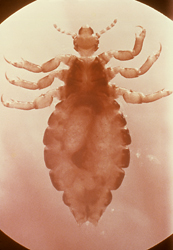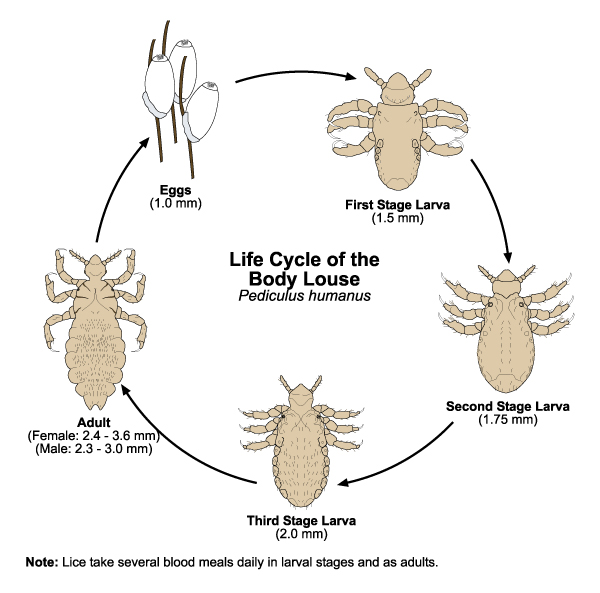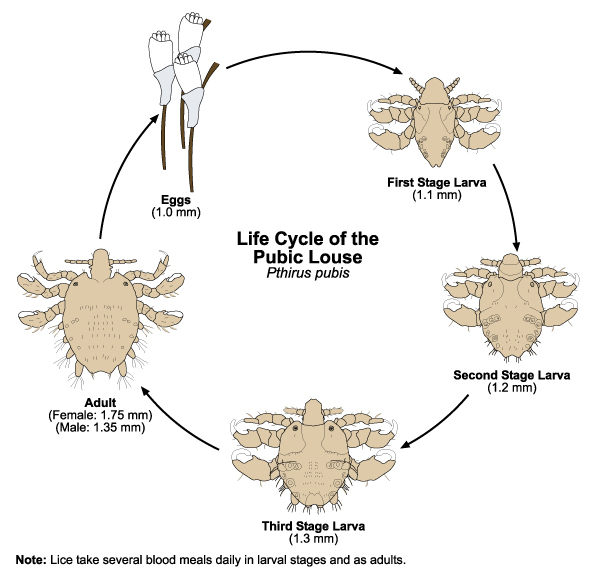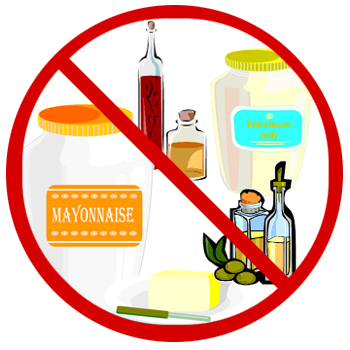| Insects > Lice |
Lice are parasitic insects that must live, feed, and reproduce on the body of a living host. Numerous information sources discuss the lice that are parasites of humans, their public health risk, methods of personal protection, and approaches to control. You are encouraged to learn more about the biology of human lice to help you make more informed decisions about health risks, how to prevent infestations, and where to find information about the control of human lice.
Are Human Lice a Public Health Risk?
The main importance of human lice in the U.S. is as blood-sucking nuisances and as a cause of social embarrassment. Human lice are not known to transmit disease agents in Indiana.
In other regions of the world, one type of human louse, the body louse, is the vector of three diseases. Historically, epidemic typhus fever and epidemic relapsing fever have caused devastating outbreaks, primarily associated with disasters such as war, but also with natural disasters such as earthquakes and hurricanes. The third disease transmitted by body lice is a non-fatal infection known as "trench fever." All three diseases are associated with situations in which humans are crowded together under conditions where sanitation is severely limited or non-existent.
| Parasitic Lice and Their Hosts Parasite lice are highly "host-specific," which means that they typically live, feed, and reproduce on a single species of animal. Lice that are parasites of dogs, cats, guinea pigs, birds, and livestock do not feed and do not reproduce on humans. These lice very rarely transfer to a human, and they die within a few hours or so if they happen to get on our bodies. This is why pets and livestock that are infested with lice are not a source of louse infestation to infants, young children, and adults. |
How Can I Recognize the Three Types of Human Lice?
As a general rule, the three types of human lice can be distinguished by where they occur on the body, as suggested by their common names. Adults of the head louse and the body louse are nearly identical in appearance, with both being about 1/8 inch long, cylindrical, and grayish-white when unfed. Adults of the pubic louse resemble miniature crabs in possessing relatively huge front legs and a somewhat crab-shaped body. This is why the pubic louse is also known as the "crab louse," and an infestation is known as "crabs."
Immature human lice are known either as "larvae" or "nymphs." and they resemble the corresponding adults, but they are smaller and paler in color. Larvae and adults of human lice are wingless and have three pairs of legs. They have a short, slender proboscis (beak) that is retracted within their head and extended only when they take a blood meal.
 |
 |
Head louse Photo by: Reed & Carnrick Pharmaceuticals |
Pubic louse Photo by: W.H.O. (World Health Organization) |
What Is the Life Cycle of Human Lice?
Human lice develop from an egg to an adult via a process of "gradual metamorphosis." This means the last larval stage develops directly into an adult without passing through a non-feeding pupal stage. Human lice have three larval stages, and each requires a blood meal before molting into the next life cycle stage. Both adult males and females feed on blood and take repeated blood meals about every 4-8 hours during their lives. Females require blood meals for the development of eggs, which commonly are known as "nits."
All life cycle stages of human lice require a live human host on which to develop. Larvae and adults typically die within a day or two if they fall off a host because they require the temperature and relatively high humidity provided by the human body. Female head lice and pubic lice glue their eggs onto the base of hairs of their host. In contrast, female body lice glue their eggs primarily onto fibers of clothing worn by an infested person, but on occasion glue them onto the base of hairs of the host. Eggs of head lice can remain viable for several days after infested head hairs fall off a host and may hatch if they experience adequate warmth and humidity inside a dwelling.
Each of the three larval stages is completed in 3-8 days. Adult females live up to 35 days and can lay up to three eggs per day. Under optimal conditions, the body louse can complete 10-12 generations per year and has the potential to develop very large numbers in groups of infested humans. Compared to the body louse, the head louse and the pubic louse take longer to complete a life cycle, have fewer generations per year, and typically do not infest humans in large numbers.
 |
Illustration by: Scott Charlesworth, Purdue University, based in part on K.C. Kim, H.D. Pratt, and C.J. Stojanovich, 1986, The Sucking Lice of North America |
 |
Illustration by: Scott Charlesworth, Purdue University, based in part on K.C. Kim, H.D. Pratt, and C.J. Stojanovich, 1986, The Sucking Lice of North America |
How Can I Recognize a Human Louse Infestation?
Human lice suck blood and in the process inject saliva that contains chemicals that cause an inflammatory response. As a consequence, itching is an initial symptom of an infestation. Close inspection usually reveals the presence of active lice on the body or in clothing in the case of the body louse. Further inspection may reveal the existence of louse eggs glued to body hairs or in the seams of clothing in the case of the body louse.
What Types of Situations Favor the Spread of Human Lice?
Human lice have the potential to transfer from person to person very quickly. The head louse spreads from an infested person to others during direct contact and indirectly when infested items such as hats, scarves, coats, combs, and brushes are shared. School-age children are at risk because they are more likely to share such items, especially under crowded conditions. The pubic louse typically spreads between human partners during sexual intercourse and other intimate contact. Spread of pubic lice via infested bedding and toilet seats can occur, but is not common because pubic lice die within a few hours once they are off a human host.
The body louse spreads during direct contact with infested people or indirectly when infested clothing is shared. Body lice also spread when they leave a person with a high fever and crawl across a surface to infest a nearby individual. Again, the body louse is capable of rapidly building very high numbers and infesting large numbers of people living in conditions that are associated with disasters such as war, hurricanes, and earthquakes when humans are crowded together without access to clean clothes, clean bedding, and periodic bathing.
How Are Human Lice Controlled?
Control of human lice typically involves the use of an insecticide together with the mechanical removal of eggs and lice, plus sanitation of infested articles such as hair brushes, hats, scarves, clothes, and bedding. Insecticides known as "pediculicides" include over-the-counter products and physician prescribed medications. For information on controlling lice and for specific chemical control products refer to the website of the Centers for Disease Control and Prevention (CDC) and discuss control options with a physician. It is essential to apply products exactly as directed on the label AND as directed on the prescription. In addition, it is important to note that eggs of human lice are not killed by insecticides, and a repeat application typically is required in 7-10 days in order to kill newly hatched larvae. Infested clothing and bedding should be washed at a minimum of 130 degrees Fahrenheit and then dried at a high temperature for 20 minutes in a clothes dryer in order to kill lice and eggs. Items that cannot be washed require dry-cleaning.
 Are Any Home Remedies Effective in Controlling Head Lice?
Are Any Home Remedies Effective in Controlling Head Lice?
There is no evidence that any of the so-called "home remedies" control head lice. Recent research under scientifically controlled conditions has shown that the following are of little or no effectiveness in treating for head lice: vinegar, isopropyl alcohol, olive oil, mayonnaise, melted butter, and petroleum jelly. Also, none of the tested materials killed head louse eggs. Additional research into the potential for "drowning" head lice showed that head lice survive being totally submerged in water for up to 8 hours.
Are Head Lice in Some Areas Resistant to Insecticides?
Resistance to approved, properly applied insecticides is a problem in the U.S., including Indiana, but the specific insecticide involved can differ from one area to another. If control is not successful after properly applying an approved insecticide, it may be possible to try an alternative insecticide. Consult with your local health care provider regarding alternatives that are effective in your area.
What Specific Things Should I Know About Human Lice?
Detailed information pertaining to the three types of human lice is summarized in "bullet" form for quick reference. Please click on the following links to learn more.
Are There Any Louse-Borne Diseases of Humans In the U.S.?
There is no louse-borne disease at this time in the U.S., but body lice are the vectors of three diseases in certain regions of the world, and travelers to these areas need to be aware. Details pertaining to epidemic typhus fever, epidemic relapsing fever, and trench fever can be found in reference listed below.
Where Can I Find More Information on Human Lice and Louse-Borne Diseases?
The following Web site contains accurate and current information on human lice and louse-borne diseases.
A recent (2002) textbook by G. Mullen and L. Durden, Medical and Veterinary Entomology, has an excellent chapter devoted to lice and louse-borne diseases that covers biology, behavior, medical and veterinary risk, and general information on prevention and control.